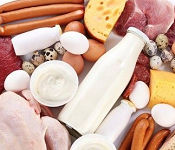
Safely Storing Dairy Products:
Proper Refrigerator and Freezer Storage Temperatures
| Product | How to Store | Refrigerator (33-40 °F) | Freezer (0 °F) |
|---|---|---|---|
| Pasteurized Fresh Whole or Skimmed Milk | Keep refrigerated with the container closed. | 1 to 5 days beyond "sell-by" date | 3 months. Freezing may result in change in texture. Thaw in refrigerator. |
| Sweetened Condensed Milk(Opened) | Tranfer from the can to a glass or plastic container, Refrigerate tightly covered. | 1 week | Do not freeze. |
| Evaporated Milk (Opened) | Refrigerate tightly covered. | 1 week | Do not freeze. |
| Cultured Buttermilk | Refrigerate immediately in original container. Keep container closed. | 2 weeks | Do not freeze. |
| Homogenized, Reconstituted Dry Nonfat and Skimmed Milk | Keep containers tightly closed. Don't return unused milk to original containers. | 1 week | Do not freeze. |
| Sweet and Regular Cream | Refrigerate immediately in original container. Keep container closed. | 1 to 5 days beyond "sell-by" date | Do not freeze. (Change of texture, body appearance. Separation of fat emulsion.) |
| Non-Dairy Whipped Topping | Keep covered. | 3 months in aerosol can. 3 days if prepared from mix. 2 weeks if bought frozen and then thawed. |
Do not freeze aerosol cans; others may be stored in freezer up to one year. |
| Butter | Refrigerate immediately in original container. Keep container closed. | 2 weeks | Butter made from pasteurized cream: 6 to 9 months. |
| Sour Cream | Refrigerate immediately in original container. Keep container closed. | 2 weeks | Do not freeze. |
| Ice Cream | Store in original container in freezer. | Do not store here. | 2-3 weeks (Opened) 2 months (Unopened) |
| Yogurt | Keep covered. | 7-10 days | Do not freeze. |
| Soft Custards, Milk Puddings, Cream and Custard Fillings for Cakes and Pies | Cool cooked dishes quickly and refrigerate within 2 hours. Refrigerate cold dishes immediately after preparation. | 5-6 days | Do not freeze. |
References
- MSU Extension
- American Home Economics Association. Handbook of Food Preparation, 9th edition, 1993.
- Bailey,J. (1993). Keeping Food Fresh. New York: Harper Perennial.
- North Carolina Cooperative Extension Service. The Notebook of Food and Food Safety Information. Rev. 1997
- Rushing, J.E., Department of Food Science, NCSU. Protecting the Safety of Milk. http://www.ces.ncsu.edu/depts/foodsci/ext/pubs/milksafety.html
- University of Missouri-Columbia (1998). Using and Storing Butter http://muextension.missouri.edu/xplor/hesguide/foodnut/gh1115.htm
